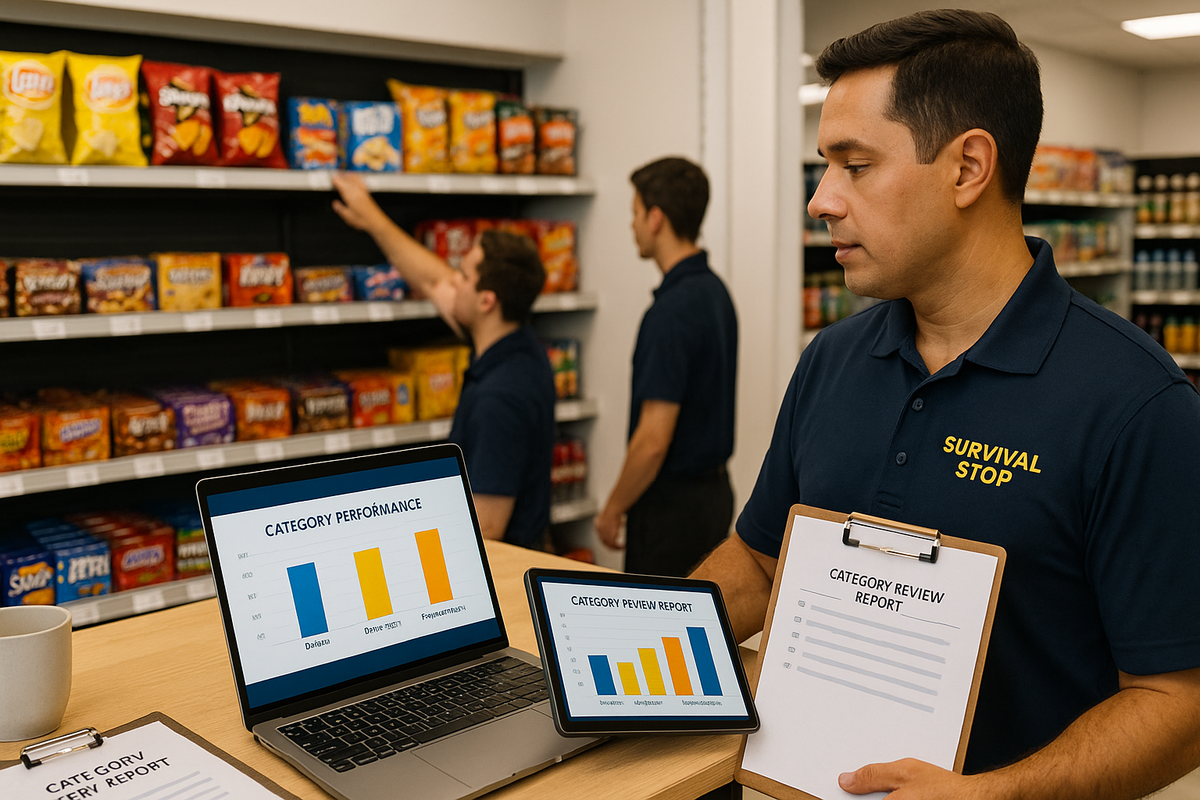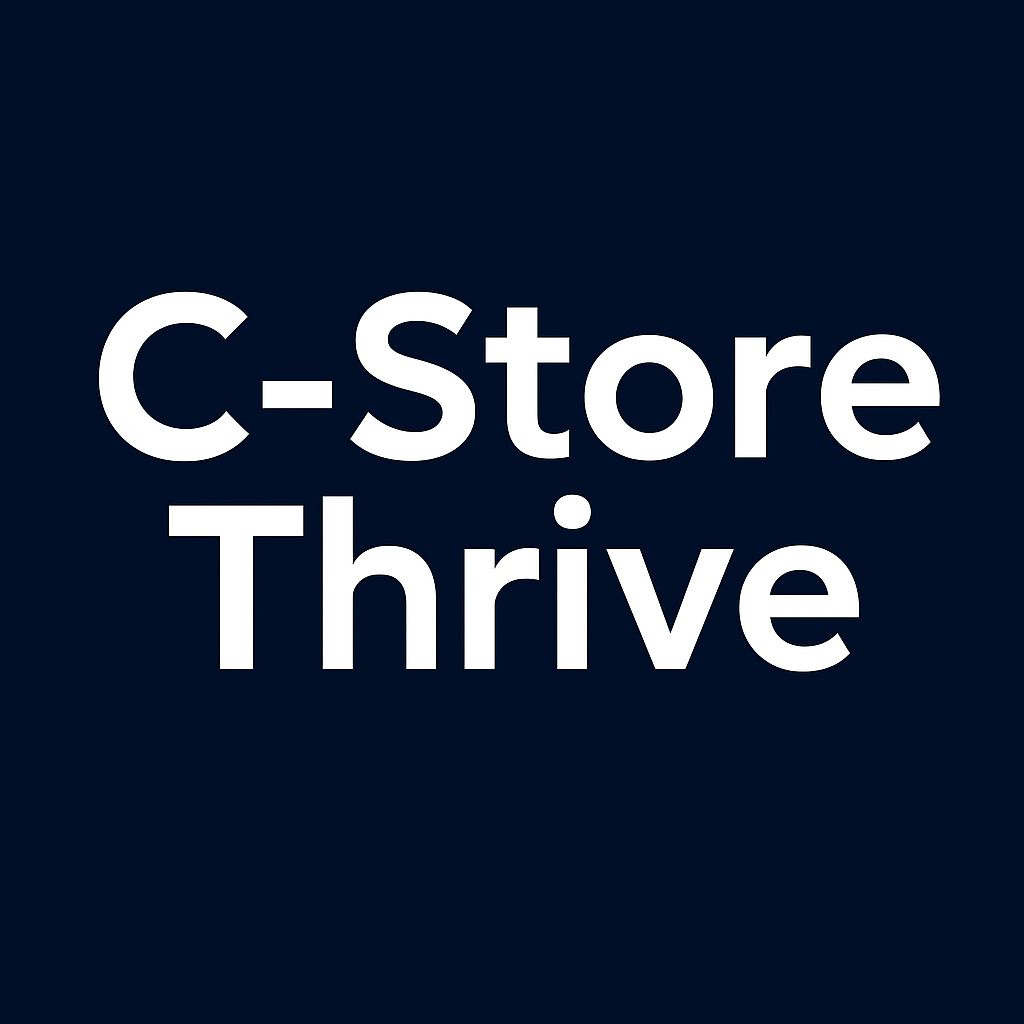Understanding the Role of Category Management in C-Stores: A Strategic Approach to Maximizing Profitability
Category management treats each product group as a distinct business unit with strategic goals and success metrics. For convenience stores, this data-driven approach maximizes limited space, drives impulse purchases, and optimizes margins across diverse categories.

Category management isn't just about arranging products on shelves—it's a strategic discipline that can transform your convenience store from a basic transaction point into a profit-maximizing destination. Here's how independent owners can harness this powerful tool to compete with major chains and drive sustainable growth.
Independent convenience store owners face an unprecedented challenge: competing against well-funded chains that leverage sophisticated category management systems while operating with limited resources and expertise. Yet the stakes have never been higher. With food service contributing over 37% of store profits despite representing just 27% of sales, and the average C-store carrying 3,000-5,000 SKUs across diverse categories, how you manage your product mix directly determines your bottom line.
The reality is stark but opportunity-rich. Stores with effective category management consistently outperform those that rely on intuition or supplier-driven decisions. They achieve higher margins, faster inventory turns, and stronger customer loyalty—all while making the most of every square foot of retail space. For independent operators, mastering category management isn't just about keeping up with the competition; it's about turning limited space into maximum profit.
What is Category Management and Why Does It Matter?
Beyond Product Placement: A Strategic Business Discipline
Category management treats each product group—beverages, snacks, tobacco, prepared foods—as a distinct business unit with its own strategy, goals, and success metrics. Rather than simply stocking what distributors recommend or copying what competitors do, it involves making data-driven decisions about which products to carry, where to place them, how much space to allocate, and when to promote them.
For convenience stores, this approach is particularly powerful because:
- Space is limited and expensive: Every square foot must generate maximum return
- Customer visits are brief: Products must be easily found and appealing enough to drive impulse purchases
- Margins vary dramatically: Food service can deliver 60-70% margins while tobacco operates at 8-12%
- Local preferences matter: What sells in urban areas may fail in rural locations
The Independent Store Advantage
While major chains have resources and data, independent stores have agility and local market intimacy. You can pivot quickly, test new products without corporate approval, and tailor your mix to specific neighborhood preferences. When done right, category management amplifies these natural advantages.
The Four Pillars of C-Store Category Management
1. Category Role Definition
Every category in your store should serve a specific strategic purpose. The most successful C-stores organize their categories into four distinct roles:
Destination Categories drive customer traffic and build store reputation. These are the products customers specifically visit your store to purchase:
- Fresh coffee programs: With 40% margins and repeat visit patterns
- Fuel: High volume, low margin but essential for traffic generation
- Lottery tickets: Regular customer engagement with steady commissions
Profit Categories deliver the highest financial returns per square foot:
- Prepared foods: 60-70% margins with growing demand
- Fountain beverages: Low cost, high markup, weather-driven sales
- Health and beauty care: Premium pricing with infrequent price shopping
Convenience Categories meet immediate customer needs and prevent trips to competitors:
- Dairy products: Milk, eggs, bread for emergency household needs
- Over-the-counter medications: High markup, impulse-driven purchases
- Phone chargers and accessories: High margins, impulse appeal
Seasonal/Promotional Categories capture temporary demand spikes:
- Holiday decorations: Short-term, high-velocity sales
- Summer beverages: Weather-dependent margin opportunities
- Back-to-school supplies: Annual predictable demand cycles
2. Space Allocation Based on Performance
The most common mistake independent owners make is allocating space based on what seems logical rather than what actually performs. Effective space allocation requires analyzing three key metrics:
Sales Velocity: How quickly products move off shelves
Gross Margin: Actual profit dollars generated per item
Return on Investment: Profit per square foot occupied
Real-world application: A typical C-store might discover that prepared foods, occupying just 10% of space, generate 25% of gross profit. Meanwhile, general merchandise might occupy 30% of space while delivering only 15% of profits. Strategic reallocation based on these insights can dramatically improve overall profitability.
3. Planogram Optimization
Planograms are visual blueprints that specify exactly where each product should be placed. For independent stores, effective planogram management involves:
The Golden Shelf Rule: Products at eye level (48-53 inches) generate 35% more sales than items on lower shelves. Reserve this premium space for:
- High-margin items you want to promote
- New products requiring trial generation
- Seasonal items during peak demand periods
Category Adjacency: Related products should be grouped together to encourage multiple purchases:
- Coffee supplies near coffee stations
- Chips and dips in close proximity
- Energy drinks near checkout for impulse additions
Hot and Cold Zones: Different areas of your store naturally receive varying customer attention:
- Hot zones: Entrance areas, checkout counters, main aisles
- Cold zones: Back corners, lower shelves, areas behind displays
- Use hot zones for impulse items and new product introductions
4. Continuous Performance Analysis
Category management is not a "set it and forget it" process. Successful independent operators review performance data regularly:
Weekly Analysis:
- Sales velocity by category and product
- Inventory turnover rates
- Out-of-stock incidents and their impact
Monthly Deep Dives:
- Margin analysis by category
- Space productivity measurements
- Customer traffic pattern assessment
Quarterly Strategic Reviews:
- Category role effectiveness
- Seasonal performance evaluation
- Competitive landscape changes
Practical Implementation for Independent Stores
Start with Your Top Performers
Rather than attempting to optimize everything at once, focus on categories that offer the biggest improvement opportunities. Most independent stores should begin with:
Food Service Category: If you're not maximizing prepared food potential, you're leaving significant money on the table. Stores adding comprehensive food programs typically see 15-25% increases in overall profitability.
Impulse Categories Near Checkout: 20% of convenience store customers make unplanned purchases, with even higher rates during evening hours. Optimize your checkout area with:
- Small-package snacks under $2
- Energy shots and supplements
- Phone accessories and batteries
- Seasonal items (sunglasses, hand warmers)
Leverage Supplier Expertise (Carefully)
Many suppliers offer category management support, but independent owners must maintain control over final decisions. Use supplier insights for:
- Market trend analysis: What's growing nationally?
- Product performance data: How do items perform in similar stores?
- Promotional planning: What promotional strategies drive results?
However, avoid letting suppliers become your "category captain" for entire sections. Their priorities (maximizing their sales) may not align with yours (maximizing your profits).
Technology Solutions for Small Stores
You don't need enterprise-level systems to implement effective category management. Start with:
Point-of-Sale Analytics: Most modern POS systems provide category-level sales reporting. Use this data to track:
- Which categories generate the highest margins
- What times of day different products sell best
- Seasonal trends and patterns
Simple Planogram Software: Tools like PlanoHero offer affordable options for creating and managing planograms. Even basic planogram compliance can improve sales by 2-3%.
Mobile Apps for Compliance: Use smartphone cameras to document planogram execution and track compliance across categories.
Category-Specific Strategies for C-Stores
Food Service: The Profit Engine
Food service represents the single biggest category management opportunity for most independent stores. Prepared food sales grew 12.2% in 2023, with successful stores generating over $50,000 monthly from this category.
Key strategies:
- Allocate prime space: Food should occupy your most visible, accessible locations
- Match offerings to dayparts: Breakfast items during morning hours, lunch options midday
- Price for profit: 60-70% margins are achievable with proper cost management
- Maintain freshness: Rotate inventory frequently to ensure quality and safety
Beverage Category: Weather-Dependent Optimization
Beverages typically contribute around 15% of C-store sales but require different management approaches based on temperature and season:
Cold Beverages (Summer Focus):
- Expand cooler space during warm months
- Stock energy drinks and sports drinks at eye level
- Create variety packs and multi-purchase promotions
Hot Beverages (Winter/Morning Focus):
- Premium coffee programs with 40% margins
- Hot chocolate and specialty teas for variety
- Positioning near registers for impulse additions
Tobacco Products: Compliance and Profitability
While margins are lower (8-12%), tobacco remains crucial for customer retention. Category management considerations:
- Regulatory compliance: Ensure proper storage and display requirements
- Age verification systems: Streamline checkout processes
- Alternative products: Consider vaping products where legally permitted
- Inventory management: Balance variety with turnover to minimize stale inventory
Snacks and Candy: The Impulse Powerhouses
These categories generate approximately 10% of sales but offer significant margin opportunities:
Strategic placement:
- Checkout areas: 67% of candy sales occur at point-of-sale
- Eye-level positioning: Children's products at child height
- Cross-merchandising: Place complementary items together (chips with dips)
Measuring Category Management Success
Key Performance Indicators
Track these essential metrics to gauge category management effectiveness:
Sales Growth: Category sales compared to previous periods
Margin Expansion: Gross profit percentage improvements
Inventory Turnover: How frequently inventory cycles through
Space Productivity: Sales per square foot by category
Customer Satisfaction: Feedback on product availability and variety
Financial Impact Assessment
Successful category management should deliver measurable financial results:
Short-term (1-3 months):
- Reduced out-of-stock incidents
- Improved inventory turnover
- Higher impulse purchase rates
Medium-term (3-12 months):
- Increased average transaction values
- Higher gross margins per category
- Reduced shrinkage and waste
Long-term (12+ months):
- Improved overall store profitability
- Enhanced customer loyalty and visit frequency
- Competitive differentiation in local market
Common Pitfalls and How to Avoid Them
Over-Reliance on Supplier Recommendations
Problem: Allowing distributors or major suppliers to dictate your product mix without considering your specific customer base and profit requirements.
Solution: Use supplier insights as input, not direction. Make final decisions based on your sales data, customer feedback, and profit analysis.
Ignoring Local Preferences
Problem: Copying successful category strategies from other markets without considering local demographics and preferences.
Solution: Test new products in small quantities before committing significant space. Monitor local events, demographics, and seasonal patterns that might influence demand.
Inadequate Performance Monitoring
Problem: Making category changes without tracking results or waiting too long between adjustments.
Solution: Establish regular review cycles and stick to them. Use your POS system data to make informed decisions quickly.
Space Allocation Based on Intuition
Problem: Giving popular brands more space without considering their actual profit contribution.
Solution: Allocate space based on profit per square foot, not just sales volume. A slow-selling but high-margin item may deserve more space than a fast-selling low-margin product.
The Future of Category Management for Independent Stores
Technology Integration
Artificial intelligence and machine learning tools are becoming accessible to independent operators. These technologies can:
- Predict optimal inventory levels based on weather, local events, and historical patterns
- Suggest planogram improvements based on customer traffic patterns
- Automate reordering for fast-moving items while flagging slow movers
Data-Driven Decision Making
The most successful independent stores are becoming increasingly sophisticated in their use of data:
- Customer analytics: Understanding who shops when and what they buy together
- Competitive intelligence: Monitoring local market trends and pricing
- Supplier performance: Evaluating which vendors deliver the best margins and service
Getting Started: A 90-Day Implementation Plan
Month 1: Assessment and Planning
Week 1-2: Data Collection
- Analyze current category performance using POS data
- Identify top-performing and underperforming categories
- Survey regular customers about product preferences and satisfaction
Week 3-4: Strategic Planning
- Define category roles based on your findings
- Set specific improvement targets for each category
- Create initial space reallocation plans
Month 2: Implementation
Week 5-6: Physical Changes
- Implement new planograms for priority categories
- Adjust space allocation based on performance data
- Install any necessary fixtures or signage
Week 7-8: Staff Training and Process Development
- Train employees on new category strategies
- Establish monitoring and compliance procedures
- Begin regular performance tracking
Month 3: Optimization and Refinement
Week 9-10: Performance Analysis
- Review sales data for implemented changes
- Identify successful strategies and areas needing adjustment
- Gather customer feedback on changes
Week 11-12: Continuous Improvement
- Refine strategies based on results
- Plan next phase of category management improvements
- Establish ongoing review and optimization processes
Conclusion: Your Competitive Advantage
Category management represents one of the most powerful tools available to independent convenience store owners. While major chains have resources and scale, you have the ability to move quickly, adapt to local needs, and implement changes without bureaucratic delays.
The key is to start systematically and build on early successes. Begin with your highest-opportunity categories—typically prepared foods and high-margin impulse items—and expand your category management approach as you gain experience and see results.
Remember that category management is not about perfection; it's about continuous improvement. Every small optimization, from moving high-margin items to eye level to eliminating slow-moving SKUs, contributes to your overall profitability and competitive positioning.
With consumer expectations rising and competition intensifying, stores that master category management will thrive while others struggle. The question isn't whether you can afford to implement category management—it's whether you can afford not to.
Start today with a single category. Measure your results. Learn from the data. And build on your successes. Your customers, your bottom line, and your competitive position will all benefit from the strategic approach that category management provides.
Ready to transform your product mix into a profit-maximizing strategy? Begin by analyzing your current category performance using your POS system data, identify your highest-opportunity areas, and implement changes systematically. The investment in category management discipline will pay dividends through improved margins, better inventory turnover, and enhanced customer satisfaction.





